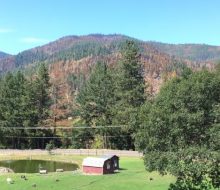By Ryan Pfeil, Sanctuary One board president
The utility and passion of an organization is something that is tested during chaotic, unforeseen events, happenings that the organization and its supporters must respond to as a united front if they hope to succeed.
If iron sharpens iron, then it’s also true that fire can make iron better.
Looking In, From the Outside
As I enter my third year on the Sanctuary One care farm board of directors, I still maintain the Applegate nonprofit’s titular test occurred nearly a decade ago, one that involved literal flames.
Back then, my role in relation to the farm was nonexistent. I was on the outside, looking in, specifically, as a reporter.
I’d written about Sanctuary One a couple times prior, most notably a feature about the facility’s decision from more than a decade ago to take on cats with FIV (the feline version of the AIDS virus.)
“The Sanctuary One animal care farm has recently announced completion of the William Driscoll and Alicia Theophil FIV Cat Cottage, a facility intended to care for cats with Feline Immunodeficiency Virus while they are kept separate from other cats,” I wrote in a story that ran April 2015. “Sanctuary One officials said stray cats that test positive for FIV are often euthanized by shelters, and that they are hoping to change that.”
It was a simple, sweet assignment that had some policy-grade seasoning. Nothing hard-hitting when compared to some of the crime or county government escapades I’ve also covered, but still important.
The Fire of 2017
Two years later, however, I’d get a taste of mayhem and Sanctuary One in one fell swoop.
Then, as now, our region endured harsh wildfire seasons during the summer months, and 2017 was a particularly brutal year. The Incident Information System, an exceedingly useful tool that tabulates individual wildfire data, including size and containment, documented more than 400,000 acres burned during the 2017 fire season.
Nearly 40,000 acres of that total acreage burned because of a series of fires that ignited in Josephine County about 17 miles east of Cave Junction. Dubbed the Miller Complex, the 25 lightning-sparked roared to life in mid-August 2017 and tore through the surrounding area.
At one point, Sanctuary One – and the animals in its care – was in its crosshairs. The facility got put under a Level 2 evacuation advisory, which means you need to be ready to flee at any time due to a fire that’s bearing down on you.
“Oregonians should be ready to leave at a moment’s notice, as this level indicates there is significant danger to the area,” Jackson County’s Emergency Management website states. “The public should be prepared to voluntarily relocate to a shelter or with family/friends outside of the affected area.”
A Community Responds
Sanctuary One was ready, but they needed help. At the time, 60 or so farm animals lived on the farm, and they needed to get away from the fire, too. And the window of opportunity was closing as flames edged closer.
“We made the decision two days ago to evacuate, to sort of get out a little bit ahead of the curve and get out a little bit early because of the task of getting this many animals off the farm,” former Sanctuary One operations manager Brian Kiesse told me nearly eight years ago.
But it wasn’t just care farm personnel and volunteers that helped transport the goats, alpacas, ducks, geese, chickens, rabbits, sheep, cats, dogs, pigs, and horses they cared for. The animal care community hopped into action.
- Ashland’s Equamore Horse Sanctuary took horses
- The Southern Oregon Humane Society took dogs
- The Jacksonville Veterinary Hospital opened its doors to felines
- Individual homeowners also stepped up.
It was the first such mass evacuation in the farm’s history, and officials pulled it off. Follow-ups from care farm staff and volunteers aided with food and medication deliveries, and to make sure the animals were being cared for properly.
“It’s really comforting to know that so many people care so much about these animals and us,” former animal care manager Melissa Hamre told me. “It’s been very smooth, but it’s incredibly challenging, because we’re trying to get the animals in the best places possible.”
In this case, iron didn’t get stronger just because of fire. The blacksmiths doing the job were humble enough to say they couldn’t do the job alone.
A Deeper Understanding
Luckily, the flames did not reach the care farm grounds. Animals eventually returned, and day-to-day operations got back to normal.
Memories of covering that evacuation are even more potent and impressive now because of my leadership role, because of the passion I’ve seen volunteers, interns and staff give to this 55-acre haven with a mission statement bold enough to suppose that animals, people, and the earth are all better when they co-exist in equitable, caring harmony; that aids those in distress and prompts others to do the same – be they animals coming from bad situations or an overwhelmed care farm that’s trying to escape a fire.
Thank You
If you’re a volunteer, staff person, or intern, thank you.
If you’ve adopted an animal into a forever home, if you’re a veterinarian or other organization that has helped care for our furry and feathered denizens, thank you.
If you are one of the hundreds upon hundreds of community members who have come to the farm during volunteer week or Open Farm Day, thank you.
If you are a donor or someone who has done something as simple as share one of our social media posts or told a friend about the care farm, thank you.
Sanctuary One is only as strong as the community that believes in it. I think about the anecdote of fire and a community’s rapid response from eight years ago that proved that to me all the time.



